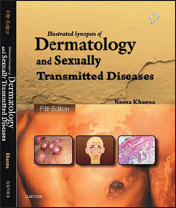Translate this page into:
Illustrated Synopsis of Dermatology and Sexually Transmitted Diseases
Correspondence Address:
Asit Mittal
Department of Dermatology, R.N.T Medical College and Attached Hospitals, Udaipur, Rajasthan
India
| How to cite this article: Mittal A. Illustrated Synopsis of Dermatology and Sexually Transmitted Diseases. Indian J Dermatol Venereol Leprol 2016;82:474 |
Author: Neena Khanna
Publisher: Elsevier Health Sciences
Binding: Paperback
ISBN: 978-81-312-4230-8
Edition: Fifth edition
Pages: 460
Price: Rs. 945/-

For more than a decade now, “Illustrated Synopsis of Dermatology and Sexually Transmitted Diseases” by Dr. Neena Khanna has remained a favorite among undergraduate medical students. The latest (fifth) edition of this book comes after a gap of almost 5 years. However, it was well worth the wait. The book aptly justifies its title:
- Illustrated: It is very well illustrated with the help of simplified line drawings (≈100) and numerous high-quality clinical and histopathological images (≈750). The title page is a good preview for readers about what to expect in the book
- Synopsis of: It is a crisp overview. The author has made sure that important details are not omitted and not-so-important ones are not included
- Dermatology and sexually transmitted diseases: The author has honestly and successfully undertaken the herculean task of covering the large spectrum of dermatology (including leprosy) and sexually transmitted diseases in the confines of 450 pages.
The book has focused on developing an understanding of dermatology in the reader, from the very basics. The main body of the textbook continues to be organized along the earlier pattern. Important diseases have been summarized as a synopsis at the beginning of the topic. Significant space has been dedicated to high-quality images and illustrations which are highly appreciable since dermatology is a visual branch. Furthermore, it serves the purpose of making the book more engaging. Images, tables and line diagrams will help the reader understand the variations in morphology and distribution of lesions which are the cornerstone of reaching a diagnosis in dermatology. The chapter on sexually transmitted infections and human immunodeficiency virus covers the subject succinctly. The author has also done well to update the chapter on therapeutics with inclusion of even newer modalities such as biologics and recent advances in photomedicine. I would call the book a masterpiece from an experienced teacher which not only every undergraduate and general physician but also even dermatology postgraduates and consultant dermatologists wanting to learn and practice dermatology should strongly consider for his or her bookshelf.
Fulltext Views
23,367
PDF downloads
11,042





